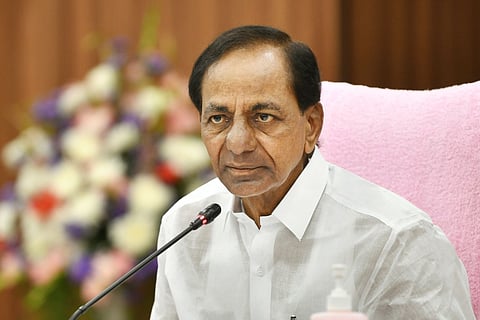

The Telangana government's proposed move to scrap a Government Order (GO) meant to protect two reservoirs in Hyderabad has sparked off a row, yet again. Speaking in the Assembly on March 15, Chief Minister K Chandrasekhar Rao had announced that the government may soon scrap the GO after receiving the report of an experts' committee.
The move has not only angered the environmentalists and citizens but has also drawn flak from Rajendra Singh, popularly known as the 'Waterman of India,' who has threatened to move the Supreme Court. So what does the GO say and what is the entire controversy about?
To understand the controversy around the GO, it is first important to understand the two reservoirs it deals with — Himayatsagar and Osmansagar. In 1908, Hyderabad witnessed one of the worst floods in its history as unprecedented rainfall led to the swelling up and overflowing of the Musi river. A few thousand people were estimated to have been killed and many more were left homeless as the floods washed away property, belongings and also resulted in the death of many cattle and animals.
Determined that Hyderabad should never bear the brunt of such a natural disaster again, the sixth Nizam of Hyderabad Mir Mahboob Ali Khan extended an invitation to noted engineer M Visvesvaraya to ‘flood-proof’ the city. Visvesvaraya then proposed two balancing reservoirs on the Musi, to ensure that the water level of the river could be controlled before it entered the city.
The Osmansagar was built in 1920 while the Himayatsagar was built in 1927. For decades after that, till the late 90s and early 2000s, the reservoirs were the main source of drinking water to Hyderabad.
It was in this context, that GO 111 was issued In 1996 by the united Andhra Pradesh government under then Chief Minister N Chandrababu Naidu.
Prior to independence, the Nizam of Hyderabad had issued a 'firman' (royal decree) that any activity or construction which polluted or obstructed the flow of water in the catchment area of the two reservoirs was banned. The GO too was on the same lines.
It simply "prohibits industries, major hotels, residential colonies or other establishments that generate pollution in the catchment of Himayatsagar and Osmansagar, up to 10 km from the full tank level (FTL) of the lakes."
However, over the years, as Hyderabad has expanded and the drinking water source of the city changed, repeated calls have now been made to scrap the GO.
Since then, several encroachments have also come up within the Full Tank Level — the maximum amount of water that the reservoir can hold when full to the brim, including a road that was constructed by the state government itself near Khanapur village. There are also many pending cases in the High Court, Supreme Court and the National Green Tribunal (NGT).
Chief Minister KCR has argued that the GO has become redundant as the two reservoirs were no longer the sources of drinking water as Hyderabad is getting piped supply of water from Krishna and Godavari rivers. However, environmentalists warn that the move could have much larger repercussions.
Rajendra Singh said he was disturbed by the "heartbreaking" news of the state government announcing the move. Singh, who is chairman of Jal Biradari, stated that the two reservoirs are the pride of not just Hyderabad but the entire nation. He added that scrapping the GO will be in violation of the Constitution and orders of the Supreme Court and that if the Telangana Chief Minister fails to drop the move, he will be forced to approach the Supreme Court.
The winner of the prestigious Magsaysay Award and Stockholm Water Prize took to Twitter to share his anger. He said he was surprised that Telangana which recently hosted a national convention on rivers is revoking GO 111. "This is against law and nature," he said.
Singh said the report of the expert committee in this situation, will also be tailor-made to suit the purpose of the government and not intended to protect the water bodies. He pointed out that the GO covers 1.32 lakh acres in 84 villages and seven mandals. He said that revoking the GO means removing the shield to protect the two lakes and amounts to the violation of several judgments of the Supreme Court and the National Green Tribunal.
"If KCR wants, he can shift these 84 villages from the catchment area and keep the catchment area free for the prestigious Himayatsagar and Osmansagar lakes. Thus, he can become a role model for other Chief Ministers," Singh said.
"Further, the state is constitutionally obligated for protection and improvement of the natural resources under the Article 48-A of the Constitution of India too, he cannot escape from it," Singh said.
According to environmentalist Dr Subba Rao, the objectives of the GO were to ensure sustainable water resource management. The reservoirs were part of the only zero-energy water distribution system in the country, where no water was pumped from the sources, and hence they were completely infused into climate change adaptation.
Meanwhile, opposition parties have also raised the issue and alleged that the government’s move was aimed at benefiting the real estate industry. Congress national spokesperson Dasoju Sravan warned that if the GO 111 was abolished, it would pollute not only Osmansagar and Himayatsagar but the entire Musi river and eventually the Nagarjuna Sagar dam, causing serious environmental issues affecting flora, fauna and people in both Telangana and Andhra Pradesh.
He also alleged that out of 1.32 lakh acres of land under the GO, one lakh acres have been forcibly acquired by top leaders of the ruling Telangana Rashtra Samithi (TRS). The Congress leader demanded an inquiry into who were the individuals who purchased lands in the area covered by GO 111 during the last eight years.
With IANS inputs